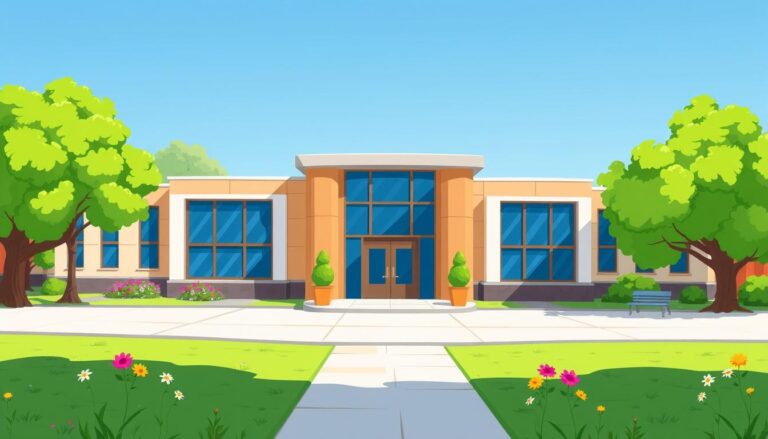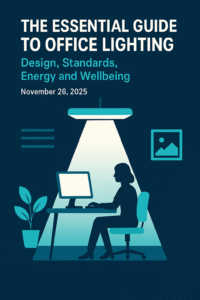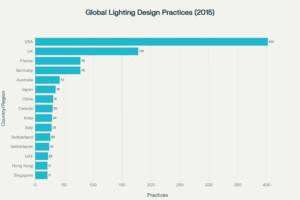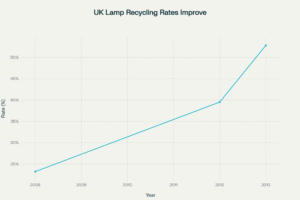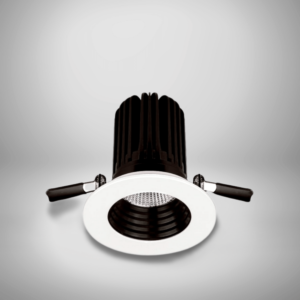Nearly 40% of electricity in some UK commercial buildings is used for lighting. This shows how much institutions and businesses alike can save by improving their lighting.
We will look at how much LED lights and controls can save in offices, schools, and retail in the UK. LEDs use less energy because they are brighter and last longer. Controls like dimming and sensors help by turning off lights when not needed.
We will use real numbers like lumens per watt and hours of life. We’ll also look at kWh savings, how long it takes to pay back, and the carbon savings. The results depend on how often places are used and the controls used.
Our goal is to help those who manage buildings and lighting. We want to help them understand the benefits and make good choices. Look for signs like UKCA/CE marking and TM‑21/L70 when choosing lighting.
We aim to be clear and helpful. We’ll show how to make lighting more efficient in the UK. We’ll also give steps to turn savings into real financial and environmental benefits.
Understanding Energy Efficient Lighting
We explain what energy efficient lighting means and why it matters for offices, schools and retail. This section sets out core concepts, practical metrics and the role of controls. So, facility teams can plan upgrades with confidence.
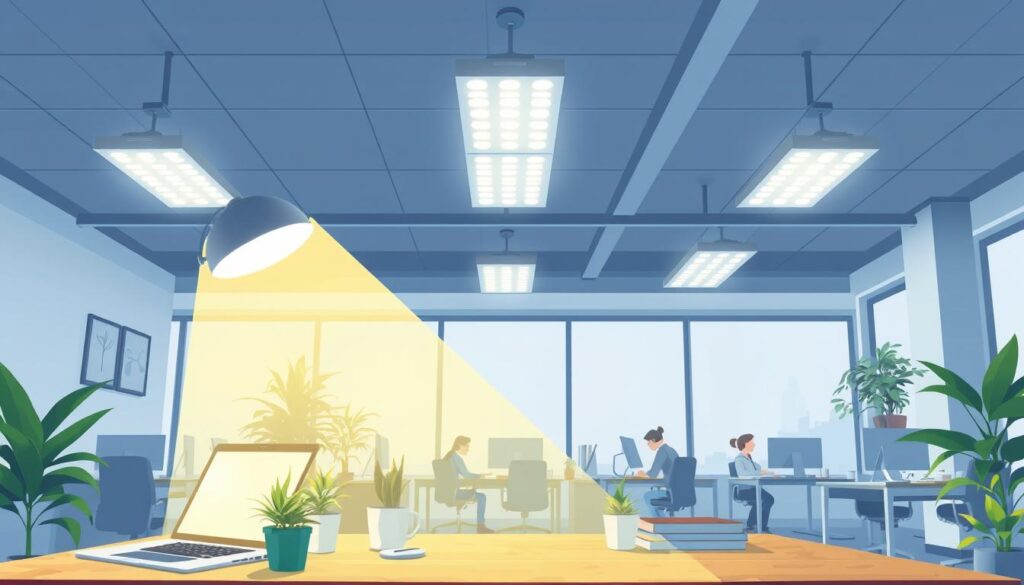
What Exactly is Energy Efficient Lighting?
Energy efficient lighting means systems that use the least energy possible. They deliver the right amount of light and visual performance. This includes high-efficiency light sources, well-designed luminaires, and targeted controls.
LEDs are the main source in modern designs. They convert electricity into light efficiently. Modern LEDs have high lumens per watt and low heat loss compared to incandescent lamps.
Key metrics guide specification. Lumens measure light output, lux quantifies illuminance, and lm/W shows efficacy. CRI assesses colour rendering and CCT describes warmth. L70 indicates the time until output falls to 70% of initial lumens.
Controls are key, not optional. Timers, dimmers, occupancy sensors, and daylight harvesting reduce run hours and average light levels. Combining source efficiency with controls improves performance beyond the lamp alone.
Key Benefits of Energy Efficient Lighting
Energy and cost savings are the main benefits. LED energy savings can reach 80–90% compared to incandescent. In real projects, LED retrofits with controls deliver 40–83% energy savings.
Typical LED lifetimes range from 25,000 to 50,000 hours. Longer life cuts lamp and labour replacement costs, reducing recurring work orders.
Performance and wellbeing improve. Stable, flicker-free light with higher CRI supports visual comfort, alertness, and task performance. This is important in classrooms and open-plan offices.
Environmental gains follow lower electricity use and smaller carbon footprints. LEDs contain no mercury, unlike many fluorescents. Products designed for refurbishment reduce long-term e-waste.
Flexibility and features add value. Dimmability, tunable white, and motion or daylight sensing support human-centric lighting strategies. They produce further operational savings when used as part of efficient commercial lighting solutions.
Practical takeaways are clear: combine high-efficiency sources with smart controls to secure the largest, most defensible savings. Use verified performance data and commission controls to guarantee savings and avoid mismatch between design intent and operational reality.
| Aspect | What to Specify | Expected Benefit |
|---|---|---|
| Source | High-efficiency LEDs, >120 lm/W where suitable | Lower kWh, clear LED energy savings |
| Luminaire | Optimised optics, glare control | Targeted illuminance, improved occupant comfort |
| Controls | Occupancy sensors, daylight harvesting, timed scenes | Lighting controls energy savings and reduced run hours |
| Metrics | Specify lux targets, CRI ≥ 80, L70 data | Predictable performance and lower maintenance |
| Operational | Commissioning and verified metering | Assured savings for efficient commercial lighting solutions |
The Rise of LED Technology
LEDs have become a popular choice in many areas. Companies like Philips, Osram, and Zumtobel offer fixtures that save energy. This change helps in making decisions for lighting in new and old buildings.
We will look at why LEDs are the best choice for lighting. We will also clear up doubts from facility teams and MEP managers.
Advantages of LED Over Traditional Lighting
LEDs use much less energy than old lights. They are 60–90% more efficient. This saves a lot of energy.
LED luminaires (those where the LED board is integrated into the fitting itself) usually last much longer than a simple LED bulb, apprximately 50,000+ hours. This means they need to be replaced less often. It also saves money and reduces disruption due to the lack of maintenance required.
LEDs focus light where it’s needed. This means less light is wasted. It also makes spaces more comfortable for people.
Common Misconceptions About LEDs
Some think LEDs are too expensive. But prices have dropped a lot. LEDs are often cheaper in the long run, even with rebates.
Others believe LEDs don’t provide good light. But high-CRI LEDs and tunable white options are just as good. They match traditional sources in many ways.
Some worry LEDs can’t work with controls. But many LEDs can be dimmed and work with sensors. The right setup can save a lot of energy.
It’s also believed that all LEDs are the same. But they’re not. Look for lumen maintenance, TM-21 projections, and driver quality when choosing.
Financial Savings in Office Spaces
We examine the financial benefits of upgrading office lighting. Small changes can lead to big savings. Upgrading to energy-efficient lighting and controls can save money in the long run.
Immediate vs. Long-Term Savings
Switching to LEDs can cut energy use right away. A 36W fluorescent can be replaced by a 20W LED, saving about 44% of energy. This means a big reduction in energy bills over time.
Using lighting controls can save even more. Devices like occupancy sensors and daylight dimming avoid wasting energy. Commissioning controls can save 10–20% more energy.
Long-term savings come from longer-lasting lamps and stable light output. High-quality LED drivers and fixtures mean less need for frequent replacements. This keeps the lights working well and reduces maintenance costs.
Payback time depends on several factors. These include how often the lights are used, the cost of electricity, and any available rebates. With the right deals, payback can happen in just a few years.
Successful Implementation
We look at a typical example of an office retrofit. Let’s say there are 500 lights, and they switch from 36W fluorescents to 20W LEDs. They work for 10 hours a day, 250 days a year, at £0.20/kWh.
| Item | Existing | After Upgrade | Annual Saving (per 500 fittings) |
|---|---|---|---|
| Power per luminaire | 36 W | 20 W | — |
| Annual kWh per luminaire | 900 kWh | 500 kWh | 400 kWh |
| Total annual kWh | 450,000 kWh | 250,000 kWh | 200,000 kWh |
| Annual electricity cost | £90,000 | £50,000 | £40,000 |
| Controls commissioning uplift | — | 10% extra saving | £4,000 |
| Maintenance saving (relamping, labour) | Higher | Lower | £5,000 |
| Typical payback | — | — | 2–4 years |
This example shows big savings from LED lights and controls. It also highlights the importance of good design and commissioning. Starting small can help prove the benefits before doing more.
Energy Efficiency in Schools
We focus on making classrooms brighter and saving money. Modern fixtures and smart controls boost comfort, help students focus, and lower costs. Schools can start by upgrading high-use areas and using simple controls.
Enhancing Learning Environments with Lighting
Lighting affects how alert and focused students are. We suggest using flicker-free LEDs with the right colour and brightness for reading. Tunable white lights can also help match the natural day-night cycle for better focus.
Old lights that flicker or take a long time to warm up should be replaced. LEDs provide steady, instant light, making it easier to see and reducing distractions. This is a clear way to save energy while improving learning.
Use sensors in places like toilets and stores. Set lights for special events and adjust them when it’s sunny. These steps save energy without hurting teaching quality.
Potential Cost Reductions for Educational Institutions
Schools spend a lot on energy. Much of this can be saved through efficiency. Focus on areas like gyms and corridors for quick savings.
Studies show big savings from LED upgrades. In some places, energy use dropped by 54% to 83%, with paybacks in under four years with rebates. These numbers show the big savings schools can make.
Real examples include gyms switching to 150W LED lights, saving about 70% of energy. Campus-wide projects have saved thousands of dollars a year. Adding controls and lower maintenance boosts these savings even more.
Start with high-payback areas, look for grants, and combine efficient lights with controls. This way, schools save money, reduce upkeep, and improve learning spaces for everyone.

Retail Lighting Solutions
We create retail lighting that boosts sales and saves energy. It’s all about combining visual appeal with energy efficiency. We choose LEDs with the right beam angles and colours to make products stand out while keeping energy costs low.
Creating an Inviting Atmosphere
Begin with directional LEDs and focused accent lighting to highlight key displays. This approach increases perceived brightness where it counts. It lets us lower ambient levels and reduce total wattage.
Use track or adjustable spotlight LEDs and high-quality optics to create contrast and depth. For fashion stores, warmer CCTs and CRI 90 work best. For supermarkets, cooler CCTs help with colour differentiation. These choices save energy and enhance product presentation.
We suggest zoning: separate task, display, and circulation areas. This makes efficient lighting solutions easier to control and maintain. Proper zoning also speeds up commissioning and reduces rework during seasonal changes.
The Influence of Smart Controls
Lighting controls save energy and shape the customer journey. Dimming, scene-setting, and zoning highlight promotions and set moods for different times. Well-tuned scenes can increase dwell time and uplift sales per square metre.
Occupancy sensors, scheduling, and daylight harvesting cut waste in storage and back-of-house spaces. These features drive measurable energy savings and reduce operating costs.
For small stores, we recommend timers and simple scene controllers. For larger chains, networked DALI or PoE systems that integrate with store management are best. Commission scenes that balance sales uplift with energy minimisation to maximise ROI.
- Practical tip: Combine merchandising plans with LED luminaires that offer beam control and high CRI to protect margins.
- Procurement: Bulk purchasing and extended warranties from recognised brands shorten payback periods.
- Performance: Regular re-commissioning keeps LED energy savings and lighting controls energy savings on track.
Environmental Impact of Switching to LEDs
Switching to LEDs can cut electricity use by up to 70%. This reduction lowers the load on the grid and cuts CO2 emissions. This is true when the power mix includes gas and coal.
Reducing Carbon Footprints with Energy Efficient Lighting
In the UK, saving 1,000 kWh from lighting can avoid 180–220 kgCO2e. This depends on the grid’s intensity that year. A mid-sized office can save tens of thousands of kWh by replacing 200 fluorescent lights with LEDs. This saves several tonnes of CO2 each year.
LEDs save more energy when used with controls. Controls like occupancy sensors and daylight dimming cut down on unnecessary use. This can reduce runtime by 20–40%, boosting the carbon savings from LED retrofits.
LEDs last much longer than traditional lamps. This means fewer replacements, which lowers emissions from manufacturing and transport. Choosing luminaires designed for refurbishment also cuts lifetime carbon.
The Role of Energy Efficient Lighting in Sustainability
LEDs don’t contain mercury, unlike many other lamps. This makes them easier to handle at the end of their life. It also lowers the risk for maintenance teams and waste processors.
We support a circular approach. We recommend choosing modular luminaires for easy component replacement. Offering take-back and refurbishment options helps keep materials in use and prevents e-waste. This fits with our goal of making every luminaire regenerative and refurbishable.
Policy and standards influence adoption. UK and EU rules favour energy efficiency and circular design. Meeting these standards can help secure grants and support net-zero targets.
Practical action involves four steps:
- Conduct an energy audit to benchmark lighting use and identify retrofit scope.
- Prioritise LED retrofits where wattage per lumen is high.
- Integrate lighting controls to maximise runtime reductions and comfort.
- Implement an end-of-life plan that includes take-back, refurbishment and recycling.
| Measure | Typical Energy Reduction | CO2e Avoided per 1,000 kWh | Key Benefit |
|---|---|---|---|
| LED retrofit | 50–70% | 180–220 kg | Lower energy use, longer life |
| Occupancy sensors | 10–30% | 18–66 kg | Reduces idle run hours |
| Daylight dimming | 15–35% | 27–77 kg | Matches light to need |
| Refurbishable luminaires | Net lifecycle reduction 20–40% | 36–88 kg | Cuts embodied emissions, reduces waste |
Combining different measures gives the best results. Solutions that pair LED energy savings with controls offer big carbon cuts and lower costs. We focus on steps that facility teams can take this year.
Comparable Technologies: Beyond LEDs
We explore alternatives to LEDs and how they perform in real-world settings. We compare their energy use, maintenance, control compatibility, and lifecycle impacts. Our goal is to provide facility teams with practical insights into Energy Efficient Lighting options.
Fluorescent lamps are often cheaper to buy. They provide good light and have been used for years. Yet, LEDs use about 60% less energy than fluorescents, leading to big savings in offices, schools, and shops.
LEDs last much longer, up to 50,000 hours, while fluorescents last 8,000–15,000 hours. This means fewer replacements, saving on labour and parts. LEDs also don’t contain mercury, making them better for the environment.
LEDs switch on instantly and dim smoothly, fitting well with modern systems. Fluorescents can flicker and take time to warm up, making LEDs better for projects needing precise control.
Fluorescents might seem cheaper at first. But, LEDs are more cost-effective when you consider energy, maintenance, and disposal costs. This makes LEDs a better choice for long-term, efficient lighting solutions.
Key comparative metrics
| Metric | Fluorescent | LED |
|---|---|---|
| Typical efficacy (lm/W) | 50–90 lm/W | 100–180 lm/W |
| Operational hours | 8,000–15,000 | 25,000–50,000+ |
| Warm-up / instant on | Warm-up required; possible flicker | Instant on; stable output |
| Control compatibility | Limited; retrofits need drivers or rewiring | Dimmable; integrates with DALI-2, KNX, Bluetooth Mesh |
| Maintenance complexity | Higher; ballast failures and mercury handling | Lower; fewer replacements and easier refurbishment |
| Environmental considerations | Contains mercury; regulated disposal | No mercury; recyclable components and refurbishment pathways |
| Typical applications | Legacy installations, short-term budgets | Offices, schools, retail, industrial upgrades |
The future of smart lighting solutions.
LEDs are getting smarter, linking up with IoT and building systems. Controls like DALI-2, KNX, and Bluetooth Mesh offer detailed scheduling and energy saving. This boosts LED energy savings and cuts costs.
Human-Centred Lighting and tunable white are becoming common. They help offices and healthcare by adjusting light to support natural rhythms. Schools also benefit from adaptable lighting for different activities and times.
New technologies like OLEDs and micro-LEDs will fill specific needs. But, LEDs are still the best choice for wide-scale commercial use.
We suggest choosing open, interoperable systems to avoid being locked into one vendor. This approach ensures future upgrades, saves energy, and adds value for building owners and managers.
Implementation Challenges and Solutions
Switching to Energy Efficient Lighting can seem tough for facility teams. Costs, technical issues, and maintenance worries are common. We’ll show you how to start saving and keep projects on track.
Addressing Upfront Costs with Incentives
High initial costs often stop upgrades. In the UK, grants, rebates, and green schemes help. Start by checking what incentives you can get to make your project more affordable.
Financing options can spread out the cost. Look into energy contracts, leasing, and on-bill financing. Buying in bulk or doing it in stages can also save money and cause less disruption. Starting small can help prove the benefits of LEDs.
When applying for funding, have clear numbers ready. Show how much energy you’ll save and how long it’ll take to pay back. This will help convince others to support your project.
Navigating Installation and Maintenance Issues
It’s important to check if your LED lights work well with your system. Make sure they’re compatible with your control gear and dimming systems. This avoids problems with sensors or building management systems.
Getting your lighting system right is crucial. Proper setup, followed by regular checks and adjustments, is key. Also, make sure you can measure how well it’s working.
Choose lights that last long and have good warranties. Opt for designs that can be updated or recycled. This helps the environment and saves money in the long run.
Update your maintenance plans to fit the new needs of your lighting. You’ll need to do less lamp changing but more checks and cleaning. Pick experienced installers and get lighting experts involved early to avoid costly mistakes.
- Try out new lighting in a few areas before doing the whole building.
- Use cost models to help decide what to buy.
- Record your energy use before changing to LEDs to see the difference.
Choosing efficient lighting needs planning, but it’s doable. Focus on finding the right incentives, setting up your system correctly, and picking durable products. This will help you save money and keep your lighting working well.
The Future of Energy Efficient Lighting
Energy efficient lighting is set for a big leap forward. LEDs, smart drivers, and controls will come together. Luminaires will join building IoT systems, sharing data on occupancy, daylight, and air quality.
This will help facilities teams cut waste and improve performance. The use of LEDs and smart controls will lead to big energy savings. This is thanks to clear setup and monitoring.
Human-centred lighting and tunable white will soon be common in offices, schools, and healthcare. Studies show it improves sleep, focus, and productivity. This makes efficient lighting a key priority for both the environment and operations.
At the component level, we’ll see better LEDs and smarter power electronics. This will cut energy use per lumen.
Circular product design will change how we buy lighting. In the UK, there will be a push for products that can be refurbished and taken back. This will encourage manufacturers to design with recycling in mind.
Retrofit projects will still cut lighting loads by 40–80%. With shorter payback times, thanks to lower HVAC loads.
We recommend choosing LED systems that work well together. Make sure they can be updated and have controls. Use incentives to speed up the adoption of energy efficient lighting.
In the next decade, data and AI will make saving energy more reliable. This will keep energy efficient lighting a cost-effective way to cut carbon emissions.
FAQ
What savings can we realistically expect from switching to LED luminaires with controls in offices, schools and retail in the UK?
Switching to LEDs with controls can save a lot of energy. Savings depend on the current lighting and how often it’s used. LEDs use less energy and last longer than old lights.
FAQ
What savings can we realistically expect from switching to LED luminaires with controls in offices, schools and retail in the UK?
Switching to LEDs with controls can save a lot of energy. Savings depend on the current lighting and how often it’s used. LEDs use less energy and last longer than old lights.
What exactly is energy efficient lighting?
FAQ
What savings can we realistically expect from switching to LED luminaires with controls in offices, schools and retail in the UK?
Switching to LEDs with controls can save a lot of energy. Savings depend on the current lighting and how often it’s used. LEDs use less energy and last longer than old lights.
How do LEDs and controls work together to increase savings?
FAQ
What savings can we realistically expect from switching to LED luminaires with controls in offices, schools and retail in the UK?
Switching to LEDs with controls can save a lot of energy. Savings depend on the current lighting and how often it’s used. LEDs use less energy and last longer than old lights.
FAQ
What savings can we realistically expect from switching to LED luminaires with controls in offices, schools and retail in the UK?
Switching to LEDs with controls can save a lot of energy. Savings depend on the current lighting and how often it’s used. LEDs use less energy and last longer than old lights.
Which metrics should facility managers use to estimate savings?
FAQ
What savings can we realistically expect from switching to LED luminaires with controls in offices, schools and retail in the UK?
Switching to LEDs with controls can save a lot of energy. Savings depend on the current lighting and how often it’s used. LEDs use less energy and last longer than old lights.
What benefits beyond energy savings do LEDs provide?
FAQ
What savings can we realistically expect from switching to LED luminaires with controls in offices, schools and retail in the UK?
Switching to LEDs with controls can save a lot of energy. Savings depend on the current lighting and how often it’s used. LEDs use less energy and last longer than old lights.
Are LEDs really better than fluorescent or incandescent lamps?
FAQ
What savings can we realistically expect from switching to LED luminaires with controls in offices, schools and retail in the UK?
Switching to LEDs with controls can save a lot of energy. Savings depend on the current lighting and how often it’s used. LEDs use less energy and last longer than old lights.
FAQ
What savings can we realistically expect from switching to LED luminaires with controls in offices, schools and retail in the UK?
Switching to LEDs with controls can save a lot of energy. Savings depend on the current lighting and how often it’s used. LEDs use less energy and last longer than old lights.
What common misconceptions about LEDs should we be aware of?
FAQ
What savings can we realistically expect from switching to LED luminaires with controls in offices, schools and retail in the UK?
Switching to LEDs with controls can save a lot of energy. Savings depend on the current lighting and how often it’s used. LEDs use less energy and last longer than old lights.
How quickly do energy and maintenance savings appear after installation?
FAQ
What savings can we realistically expect from switching to LED luminaires with controls in offices, schools and retail in the UK?
Switching to LEDs with controls can save a lot of energy. Savings depend on the current lighting and how often it’s used. LEDs use less energy and last longer than old lights.
Can you provide an example of a successful office retrofit?
FAQ
What savings can we realistically expect from switching to LED luminaires with controls in offices, schools and retail in the UK?
Switching to LEDs with controls can save a lot of energy. Savings depend on the current lighting and how often it’s used. LEDs use less energy and last longer than old lights.
How does lighting affect learning environments in schools?
FAQ
What savings can we realistically expect from switching to LED luminaires with controls in offices, schools and retail in the UK?
Switching to LEDs with controls can save a lot of energy. Savings depend on the current lighting and how often it’s used. LEDs use less energy and last longer than old lights.
What cost reductions are typical for educational institutions?
FAQ
What savings can we realistically expect from switching to LED luminaires with controls in offices, schools and retail in the UK?
Switching to LEDs with controls can save a lot of energy. Savings depend on the current lighting and how often it’s used. LEDs use less energy and last longer than old lights.
How should retailers balance appearance and efficiency?
FAQ
What savings can we realistically expect from switching to LED luminaires with controls in offices, schools and retail in the UK?
Switching to LEDs with controls can save a lot of energy. Savings depend on the current lighting and how often it’s used. LEDs use less energy and last longer than old lights.
Do smart controls influence sales as well as energy use?
FAQ
What savings can we realistically expect from switching to LED luminaires with controls in offices, schools and retail in the UK?
Switching to LEDs with controls can save a lot of energy. Savings depend on the current lighting and how often it’s used. LEDs use less energy and last longer than old lights.
How do we translate kWh savings into carbon reductions?
FAQ
What savings can we realistically expect from switching to LED luminaires with controls in offices, schools and retail in the UK?
Switching to LEDs with controls can save a lot of energy. Savings depend on the current lighting and how often it’s used. LEDs use less energy and last longer than old lights.
What sustainability benefits do LEDs offer beyond energy cutbacks?
FAQ
What savings can we realistically expect from switching to LED luminaires with controls in offices, schools and retail in the UK?
Switching to LEDs with controls can save a lot of energy. Savings depend on the current lighting and how often it’s used. LEDs use less energy and last longer than old lights.
How do fluorescents compare to LEDs in cost-benefit terms?
FAQ
What savings can we realistically expect from switching to LED luminaires with controls in offices, schools and retail in the UK?
Switching to LEDs with controls can save a lot of energy. Savings depend on the current lighting and how often it’s used. LEDs use less energy and last longer than old lights.
What future smart lighting trends should we plan for?
FAQ
What savings can we realistically expect from switching to LED luminaires with controls in offices, schools and retail in the UK?
Switching to LEDs with controls can save a lot of energy. Savings depend on the current lighting and how often it’s used. LEDs use less energy and last longer than old lights.
How can we manage upfront costs for LED and controls projects?
FAQ
What savings can we realistically expect from switching to LED luminaires with controls in offices, schools and retail in the UK?
Switching to LEDs with controls can save a lot of energy. Savings depend on the current lighting and how often it’s used. LEDs use less energy and last longer than old lights.
What installation and maintenance pitfalls should we avoid?
FAQ
What savings can we realistically expect from switching to LED luminaires with controls in offices, schools and retail in the UK?
Switching to LEDs with controls can save a lot of energy. Savings depend on the current lighting and how often it’s used. LEDs use less energy and last longer than old lights.
What are practical first steps for a facilities team wanting to upgrade lighting?
FAQ
What savings can we realistically expect from switching to LED luminaires with controls in offices, schools and retail in the UK?
Switching to LEDs with controls can save a lot of energy. Savings depend on the current lighting and how often it’s used. LEDs use less energy and last longer than old lights.
